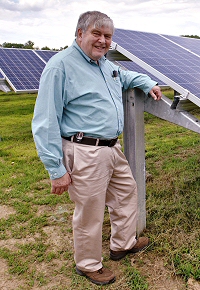Dam fine idea

Hydropower dam at Chittenden Falls, Kinderhook Creek, Columbia County
A first-of-its-kind agreement will enable Skidmore to generate 18 percent of its electrical
demand from a refurbished hydropower facility on Kinderhook Creek in Columbia County.
In 2012, a confluence of bad news and good news generated a particularly creative
thought in the minds of Mike Hall and, just across town, Omay Elphick '93. The bad
news was that many small hydroelectric dams in New York State were growing old, needing
repairs, and earning insufficient incomes from depressed electricity prices. The good
news was the state legislature's supporting of renewable energy by allowing "remote
net metering," whereby renewable energy can be generated in one location and credited
to its producer in another location. A renewables advocate and developer, Elphick
says the legislation was an "aha moment" for him. And Hall, Skidmore's longtime former
budget director and now its specialist for energy projects, says, "I immediately jumped
on the idea of a small hydro project for Skidmore."

Budget and energy expert Mike Hall
spearheaded both the Chittenden Falls
project and the College's new solar
array.
Hall partnered with Elphick as director of power marketing at Gravity Renewables,
a firm with small hydro plants and development interests across the country, and they
soon settled on a promising dam at Chittenden Falls on Kinderhook Creek, about 60
miles south of campus.
The agreement established between Skidmore and Gravity renewables represents the first
hydroelectric project in the country to make use of "remote net metering"—a policy
mechanism that, with National Grid as the intermediary, allows Skidmore to use power
generated at Chittenden Falls, even though it is generated 60 miles from the campus.
Up to 4.1 million kilowatt-hours of renewable energy will be generated annually at
Chittenden Falls, reducing Skidmore's carbon footprint by an estimated 3,000 tons
per year and providing predictable low-cost power over the 20-year operating agreement.
Last week, Skidmore celebrated the completion of a photovoltaic solar array that will
annually generate 2.6 million kilowatt hours of electricity, enough to meet 12 percent
of Skidmore's needs. Combined with the Chittenden Falls facility, that brings to 30
percent the total amount of Skidmore's electrical demand that will be met by renewable
power.
"Both projects show how we can develop new environmentally responsible and cost-effective
energy sources through new partnerships and creative thinking," said Philip A. Glotzbach,
Skidmore president. "We are delighted to be joined with Gravity Renewables in this
pathbreaking rebirth of electrical generation at Chittenden Falls."
Glotzbach credited Hall for spearheading Skidmore's participation in the project.
"All Skidmore owns is the meter box," notes Hall. "Without any up-front investment
and without building any infrastructure ourselves, we're locking in cost-savings and
a clean, reliable and predictable source of power for decades to come."
The subject of an article written by John McPhee and published the New Yorker in 1981, the Chittenden Falls dam was built in1810 to run a paper mill and then refitted
to supply electricity to the power grid in 1979. The agreement calls for the facility
to be refurbished, with renovations including an on-site classroom that will serve
as a learning resource for students and faculty.
"Skidmore College is establishing itself as renewable energy leader," said Ted Rose,
CEO of Gravity Renewables. "This project's impact goes beyond the clean energy benefits.
Skidmore is supporting one of upstate New York's historic economic drivers-each small
hydro facility employs local operators, pays taxes and supports the local economy."
Governor Cuomo and the New York State Legislature's commitment to locally produced
renewable energy, as well as National Grid's support, helped make the operating agreement
possible. New York's Net Metering Policy, which allows customers to apply renewable
energy credits to other accounts they own, allows Skidmore to sign the 20-year agreement
for the power generated at Chittenden Falls. The agreement protects Skidmore against
future price spikes or rate increases by locking in reliable, predictable low-cost
energy at a fixed rate.
Hall is gratified that environmental studies faculty are keen to use the facility
for course work, and Elphick says, "I love the academic potential—to study issues
from electricity generation to economic development, from policy and tax law to environmental
impacts."


